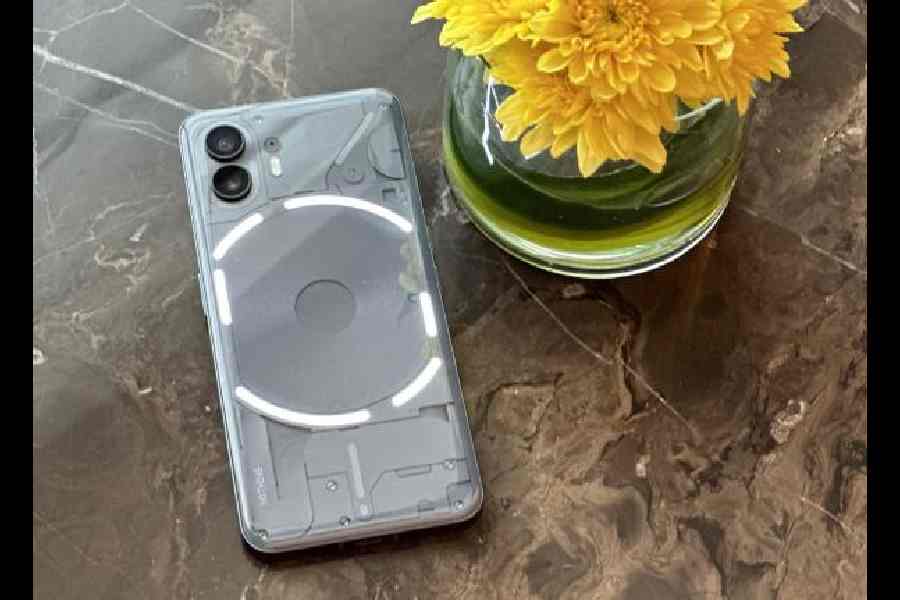If Apple has kept the conversation moving around health, privacy, environment and camera, Google has taken the buzz into AI land. And Samsung has a bit of everything. Here are our favourite phones of the year.
iPhone 15 Pro Max
It’s one of the best iPhones in years because of the improvements made to the camera system. Further, it comes with a titanium body (making it lighter), USB-C charging and Action Button. The iPhone 15 Pro Max comes with the equivalent of seven pro lenses. You get macro, 13mm ultra-wide f/2.2, 24mm f/1.78 main camera, a 28mm and 35mm FOV shift from that main camera, the 2x 48mm equivalent FOV from the previous iPhone, and finally either 77mm f/2.8 on the iPhone 15 Pro or the new 120mm f/2.8 which comes only on the iPhone 15 Pro Max.

iPhone 15 Pro and Pro Max are the first smartphones with Thread
Apple has introduced a new camera this year in the 5x 120mm equivalent tetraprism-enabled zoom. It’s a triumph. Built into the same size lens as the other cameras and utilising a clever tetraprism that bounces light around inside the casing of your phone, the lens delivers incredible image quality in both photos and videos. It’s a huge new tool in the iPhone photography kit and it blew me away. The ability to reach out to grab detail previously not possible, or to have a tight framing, or to enhance the emotive quality of my images is both surprising and welcome. Though the wide lenses are much improved as well, the new lens stands out with its ability to isolate and craft frames quickly on the fly. It’s going to make you a better photographer and it’s going to do it automatically.
We’ve, of course, had the ability to shoot ProRes Log for a while now using third-party apps like Filmic Pro and Cinema P3 and with those you can get great results but now with Apple’s version of Log, it’s the closest Log I’ve seen to a traditional camera.
Samsung Galaxy S23 Ultra
What Samsung does is simple — add all the features possible on a phone, that is, brightest of screens, fast processor, big specs on the camera front, and even a stylus. The elephant in the room or should we say inside the camera module is Samsung’s 200MP sensor. To appreciate what the camera does, there are some technical details to remember. You can take full 200MP photos from a tiny camera but the file sizes will be huge, like 40-50MB. Generally speaking, you will be shooting at around 12MP, so you get smaller file sizes. The phone uses something called pixel binning which combines 16 pixels into one.
Low-light photography on the Galaxy S23 Ultra is brilliant. Previously, the problem with low-light performance was high capture time. Now the camera is capturing and processing way quicker than its predecessor. The lower the light, lower the quality of information that each individual pixel can pick up. There is a benefit from multiple pixels being grouped together. There is definitely more texture and better control over super-bright spots. Plus, its 10x zoom is the best in the industry. It’s a phone that will see you through for years.
Pixel 8 Pro
The Harry Houdini phone. Suddenly, Google has made megapixels just another thing on the spec sheet while focusing on what is achievable by employing AI. There’s a 50MP main camera sensor with f/1.68 aperture. The Pro’s 5x telephoto module is attached to a 48MP camera with excellent autofocus, and there’s a new higher-res 48MP sensor in the ultrawide camera, which can now focus as close as two centimetres in macro mode. On the front, is a 10.5MP camera with autofocus. Plus, the Pixel 8 Pro comes with some pro camera controls to help adjust focus, shutter speed, which lens is being used, and access 50MP JPEG or RAW shooting from the native camera app. These are technical details.

Google Pixel 8 Pro makes AI shine and promises very long Android software and security upgrades
The big AI features are Video Boost, Audio Magic Eraser, Magic Editor, Zoom Enhance and Best Take. All the magic has been made possible by Google’s own Tensor G3 processor. If Apple’s chipsets are about boosting devices to work faster than those from rival companies, Google is ensuring its chipset can handle AI like no other. Both the new Pixel phones will do way more machine learning on device compared to, say, the Pixel 6. It’s useless to get into the number of cores and GPU details because these are among the best in the market. Forget percentages because it’s the real-world experience that matters. We are reaching a point where one will ask: “Is it real?”
Nothing Phone (2)
Phone (2) from London-based Nothing goes beyond the obvious by being a design-first smartphone. This year’s darker colour option is a deep grey, which I think works better to highlight the textured panels beneath the back plate. It’s a phone that has the retro feel because of the fonts and design that have been used but, at the same time, it’s futuristic because of how the interface has been designed.
Any talk about design would be incomplete without mentioning the glyph interface on the back… you know, the white LEDs that glow brightly. There have been several updates over Phone (1) but the idea remains the same, important one — stop doomscrolling.

Glyph interface action on Nothing Phone 2
So, how’s the camera? Honestly, it’s very good and it’s very much like on many other Android phones. I know how far the Sony IMX890 sensor on the main camera and Samsung JN1 sensor on the 50MP ultra-wide camera can be pushed. These are good sensors that take very good photographs under sunshine. Even under dim lighting, you will get presentable pictures and it’s great that there is no useless macro camera.
At a time when premium mid-range phones don’t have a personality, Nothing Phone (2) comes with enough of it. It’s clearly a phone with a simple message: You are an individual who needs to standout in the crowd.

Samsung Galaxy Z Flip5
If foldable phones are what you are looking, this flip option is top-notch. The Flip is still adorable but what it now has is a bigger cover screen, a new hinge and a new SoC. But the most exciting part: You won’t have to always flip it open for simple tasks, and the screen durability and battery life have also picked up steam. Attracting your colleague’s envy is the way the phone now closes fully without leaving a gap between the two halves, also the big outer screen. Frankly, the gap between the two halves wasn’t that big last year but it did allow room to gather dust. This time, there is no gap when the phone is closed and it’s thinner.
With the new much bigger 3.4-inch cover screen you definitely don’t have to open the phone nearly as much. The cover screen takes up half of the phone’s outside and the larger size definitely makes it a lot more functional. Apps like YouTube and Netflix are pretty usable on this screen, maps don’t look cramped and scrolling is easy. There are rival flip devices — from Motorola and Oppo — but Samsung has done a far better job with software as well as design.











